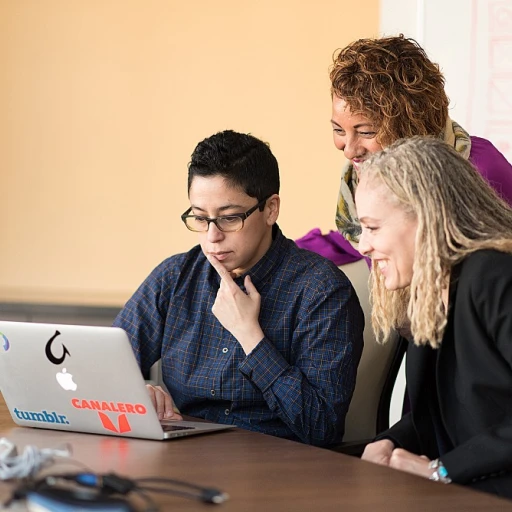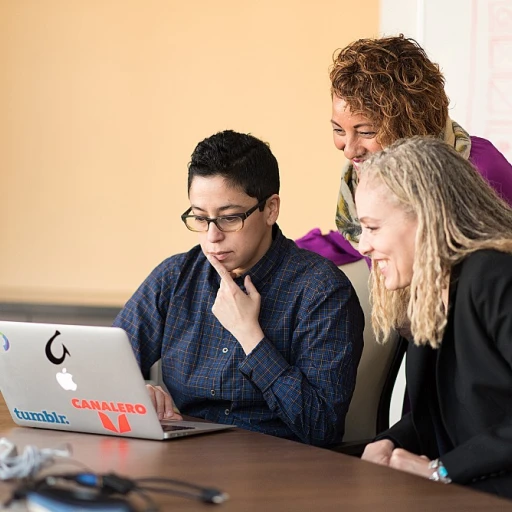Why Digital Onboarding is a Game Changer
Revolutionizing the Onboarding Process
In today’s fast-paced work environment, digital onboarding has emerged as a vital element in streamlining the integration of new employees into a company. Its significance goes beyond simply making the onboarding process more efficient; it transforms the way organizations welcome new team members, ensuring a smoother transition and a more engaging experience.
Traditional onboarding methods often involved numerous in-person meetings, extensive paperwork, and manual processes that could be both time-consuming and overwhelming for new hires. In contrast, digital onboarding harnesses the power of technology to deliver a more effective and organized approach.
Streamlined and Efficient Experience
Digital onboarding introduces a level of efficiency that is hard to achieve with conventional methods. By utilizing online platforms, companies can automate several aspect of the onboarding process, minimizing time delays, and reducing human error. This shift allows HR teams to focus on more complex and personal aspects of integrating new team members, enhancing overall productivity.
Moreover, digital onboarding platforms often offer new employees the ability to complete tasks at their own pace, from signing documents to watching training videos. This flexibility not only alleviates stress but also empowers new hires to take charge of their onboarding experience.
The Role of Digital Onboarding in Remote Work
As remote work becomes increasingly prevalent, digital onboarding adapts to this new landscape by providing seamless integration for employees who may never set foot in a physical office. With the right tools and strategies in place, companies can ensure that remote employees feel connected to their new teams from day one.
For more insights into tech hiring for remote jobs, explore the opportunities that digital onboarding can unlock
here.
To fully embrace the advantages of digital onboarding, it's essential to understand how it fits into the broader category of recruitment technology and supports the ultimate goal of creating a welcoming and supportive environment for every new hire.
The Right Tools that Make a Difference
In today’s increasingly digital world, leveraging technology is crucial for creating an efficient and engaging onboarding process. Several tools can significantly enhance your digital onboarding strategy, ensuring new hires feel welcomed and prepared. Here are some essential ones to consider:
- Onboarding Software Platforms: Central to any digital onboarding process, these platforms streamline everything from document management to task automation. They help in managing paperwork digitally, providing a single point of access for all necessary forms and information.
- Communication Tools: Effective communication is key. Platforms like Slack or Microsoft Teams facilitate real-time communication and collaboration, helping new hires integrate into the company culture quickly.
- Learning Management Systems (LMS): Training and development are integral to onboarding. An LMS can provide new employees with access to training modules, ensuring they have the necessary knowledge and skills for their role right from the start.
- Recruitment CRM: Streamlining the onboarding process involves integrations across different platforms. A recruitment CRM can be invaluable, allowing you to track applicants and store their information in a cohesive manner. Learn more about the power of recruitment CRM software here.
- Feedback Tools: Continuous feedback is vital in improving the onboarding process. Tools designed for regular check-ins and performance reviews can provide insights into how new hires are settling in and what might need improvement in the onboarding experience.
Adopting these technological tools not only ensures a smoother onboarding process but also sets up new hires for success by providing them with the resources and support they need from day one. As these tools continue to evolve, they will play an increasingly important role in enhancing the onboarding experience.
Building a Strong Onboarding Program
Crafting a Tailored Onboarding Journey
Building a robust onboarding program is crucial for ensuring that new hires have a seamless transition into their roles. An effective onboarding process fosters engagement, reduces turnover, and sets the stage for future success.
One of the key elements of a strong onboarding program is personalization. Tailoring the onboarding experience to align with the needs and expectations of each new employee can foster a sense of belonging and boost morale right from the start. It's important to understand that no two employees are exactly alike; hence, a one-size-fits-all approach might not yield the best results.
Integrating Learning and Development
Another crucial aspect of a well-rounded onboarding program is the integration of continuous learning opportunities. Providing access to training materials and development resources helps new hires feel empowered and supports their professional growth. By offering these opportunities, companies can effectively upskill their workforce, paving the way for innovation and adaptability.
Moreover, equipping employees with the right tools and resources is essential. This ensures they can efficiently perform their duties and integrate smoothly into the company's culture. For more information on the impact of technology on inclusivity and diversity in the workplace, consider reading about
how technology is shaping diversity in hiring.
Fostering a Supportive Environment
Creating an environment that encourages open communication and collaboration is integral to a strong onboarding program. Setting up regular check-ins and feedback sessions offers new hires the opportunity to voice their concerns and suggestions. This not only helps them feel heard but also aids in identifying potential areas of improvement for the onboarding process itself.
In conclusion, crafting a comprehensive onboarding journey requires a fine balance of personalization, learning opportunities, and support. By investing in a well-planned onboarding program, companies can ensure their new employees feel welcome, valued, and ready to contribute effectively.
Enhancing Employee Experience with Digital Onboarding
Streamlining the Onboarding Journey
When it comes to integrating new hires, offering a smooth and welcoming experience is essential. Digital onboarding provides a host of benefits, but one of its major strengths lies in enhancing the employee journey.
With traditional onboarding methods, new employees often face piles of paperwork and mundane processes, leaving them uninspired and overwhelmed. Digital onboarding transforms this experience by streamlining setup tasks, automating routines, and incorporating engaging content that excites and informs new hires.
Using digital platforms, employees can access onboarding materials from anywhere, resulting in a more flexible and personalized experience. As a result, new hires feel valued, motivated, and ready to contribute right away.
Boosting Engagement with Interactive Tools
A remarkable way digital onboarding enhances employee experience is through interactive tools. Incorporating elements like video introductions, virtual tours, or gamified learning can keep new employees engaged and excited about joining the organization. These tools not only make the process enjoyable but also help in understanding the company culture and values more effectively.
Moreover, regular updates and feedback features within these tools ensure that new hires have all their questions addressed promptly, encouraging open communication and fostering a supportive environment.
Fostering Connections in the Digital Workspace
Building connections with colleagues and mentors is crucial, especially in an increasingly remote work environment. Digital onboarding facilitates this by integrating networking opportunities and collaboration platforms right from the start. New employees can join interest groups, professional circles, and interact with their teammates, creating a sense of belonging and camaraderie.
Investing in these interactive and social aspects of digital onboarding can significantly improve newcomer engagement and satisfaction, setting the stage for a successful employment journey.
In conclusion, enhancing the employee experience through thoughtful digital onboarding methods can lead to a more committed and productive workforce, creating long-term benefits for the organization.
Overcoming Challenges in Digital Employee Onboarding
Addressing Technical Issues
Even with the best digital onboarding process, technical hurdles can sometimes arise. It's crucial to be prepared for potential issues such as software incompatibility, system downtimes, or connectivity problems. To overcome these challenges, ensure you have a dedicated technical support team in place that can swiftly address such issues. An effective technical support system will not only resolve problems quickly but also improve the overall onboarding experience.
Catering to Different Learning Styles
It's important to recognize that employees have varied learning preferences. While some individuals thrive in virtual environments, others may need additional support. To accommodate diverse learning styles, consider offering a range of resources, such as video tutorials, interactive sessions, and written guides. By doing so, you provide new hires with multiple avenues to understand their roles and responsibilities, enhancing their comfort and confidence.
Ensuring Engagement and Interaction
One of the common challenges with digital onboarding is maintaining engagement and interaction. Unlike traditional onboarding, digital platforms can sometimes lead to a feeling of isolation for new employees. To tackle this, introduce regular virtual meet-ups or live chat sessions with team members. Encouraging participation in team-building activities during the onboarding phase can also foster a sense of belonging.
Feedback and Continuous Improvement
Implementing a feedback mechanism is essential to refine the digital onboarding process constantly. Encourage new employees to share their experiences and suggestions. Analyzing this feedback will help identify areas of improvement and ensure that the onboarding program evolves to meet the needs of future hires effectively. Continuous improvement is key to staying ahead in the ever-changing landscape of digital onboarding.
Understanding and overcoming these challenges will empower organizations to leverage digital onboarding to its full potential, providing a seamless and enriching experience for each new team member.
Future Trends in Digital Onboarding
Anticipating the Digital Evolution in Onboarding
As we delve into the realm of digital onboarding, it's crucial to keep an eye on the evolving trends that promise to revolutionize this domain. Staying ahead of these trends can offer a competitive edge in creating a seamless and effective onboarding experience.
AI and Machine Learning in Onboarding
Artificial intelligence (AI) and machine learning are gradually becoming key players in several areas, and digital onboarding is no exception. These technologies can assist in tailoring onboarding programs to individual needs, thereby optimizing the experience for every new hire.
AR and VR: Immersive Experiences
Augmented reality (AR) and virtual reality (VR) are making waves as innovative tools for training and onboarding. These technologies offer immersive experiences that can help new employees grasp complex concepts and procedures in a more engaging manner.
Data-Driven Decisions
Leveraging big data and analytics in onboarding can provide valuable insights into the effectiveness of onboarding processes. By analyzing patterns and outcomes, companies can continuously refine their approach to better meet the needs of newcomers.
Integration with HR Tech
The future of digital onboarding is also closely tied to the integration with broader HR technology ecosystems. This integration facilitates a smoother onboarding journey by connecting the dots between recruitment, onboarding, and employee management.
In summary, digital onboarding is set to become more sophisticated and effective as these trends continue to evolve. By embracing these advancements, organizations can ensure their onboarding processes not only keep pace with the technological landscape but also provide a standout experience for new hires.













